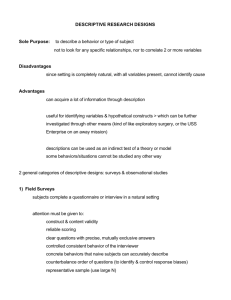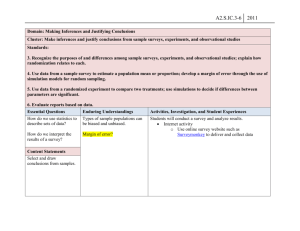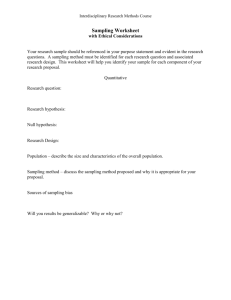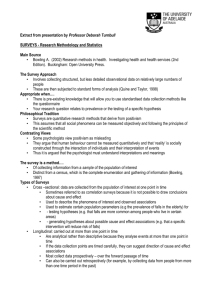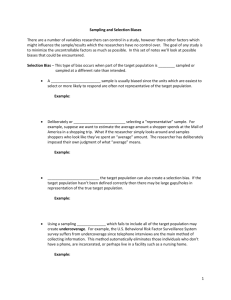Study Guide – Examination #2
advertisement
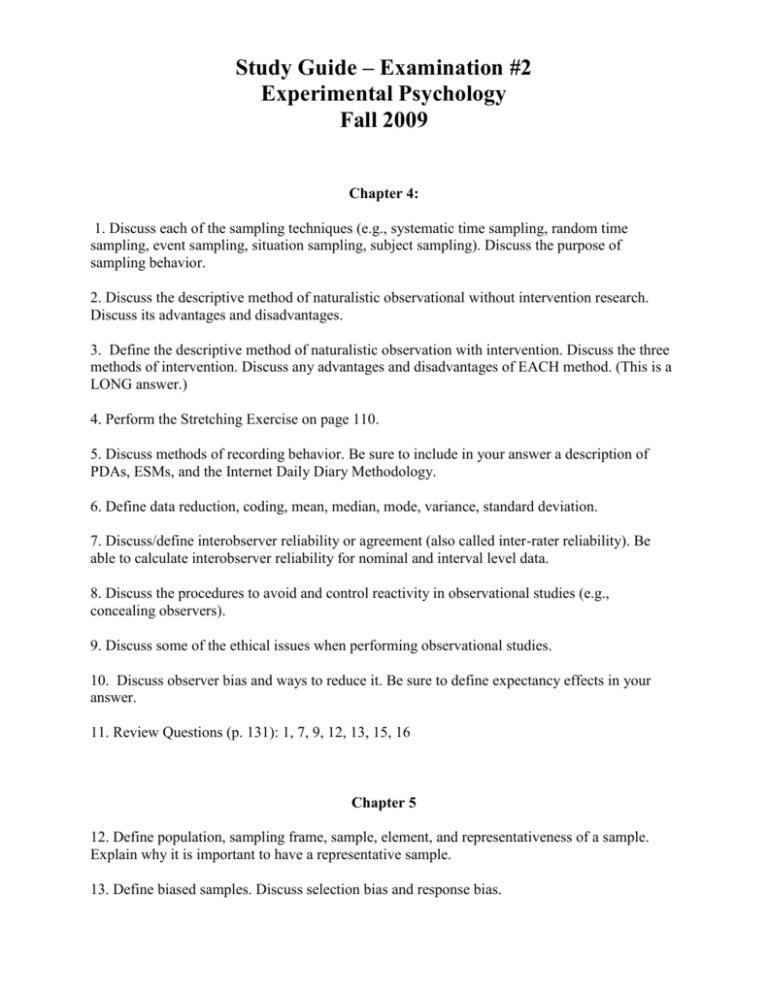
Study Guide – Examination #2 Experimental Psychology Fall 2009 Chapter 4: 1. Discuss each of the sampling techniques (e.g., systematic time sampling, random time sampling, event sampling, situation sampling, subject sampling). Discuss the purpose of sampling behavior. 2. Discuss the descriptive method of naturalistic observational without intervention research. Discuss its advantages and disadvantages. 3. Define the descriptive method of naturalistic observation with intervention. Discuss the three methods of intervention. Discuss any advantages and disadvantages of EACH method. (This is a LONG answer.) 4. Perform the Stretching Exercise on page 110. 5. Discuss methods of recording behavior. Be sure to include in your answer a description of PDAs, ESMs, and the Internet Daily Diary Methodology. 6. Define data reduction, coding, mean, median, mode, variance, standard deviation. 7. Discuss/define interobserver reliability or agreement (also called inter-rater reliability). Be able to calculate interobserver reliability for nominal and interval level data. 8. Discuss the procedures to avoid and control reactivity in observational studies (e.g., concealing observers). 9. Discuss some of the ethical issues when performing observational studies. 10. Discuss observer bias and ways to reduce it. Be sure to define expectancy effects in your answer. 11. Review Questions (p. 131): 1, 7, 9, 12, 13, 15, 16 Chapter 5 12. Define population, sampling frame, sample, element, and representativeness of a sample. Explain why it is important to have a representative sample. 13. Define biased samples. Discuss selection bias and response bias. 14. Discuss nonprobability and probability sampling. Include in your answer descriptions of accidental, purposive, simple random, and stratified sampling. 15. Discuss the survey method of mail surveys. Discuss the advantages and disadvantages of mail surveys. 16. Discuss the decision points in designing the questionnaire (i.e., generating questions, wording questions, response forms, order of questions, and pilot testing). Discuss the four ways bias can be introduced into a questionnaire. Discuss the seven common wording errors in questionnaires. 17. Discuss personal interviews. Discuss advantages and disadvantages of the interview method. 18. Discuss the telephone interview. Discuss advantages and disadvantages of the telephone interview method. 19. Discuss internet surveys. Discuss the advantages and disadvantages of this method. 20. Discuss each of the survey-research designs. State the advantages and disadvantages of each design. (Note: This is a long answer.) 21. Discuss the techniques of test-retest, alternate form, and split-half reliability. Discuss the advantages and disadvantages of each. 22. Define the six measures of validity presented in class: (1) face validity, (2) content validity, (3) predictive validity, (4) construct validity, (5) convergent validity, and (6) discriminant validity. 23. Discuss the correspondence between reported and actual behavior. 24. Discuss why one cannot imply causation from correlational data. Define spurious relationship, mediator variable, and moderator variable. 25. Review Questions (p. 176 - 177): 1, 2, 3, 4, 5, 7, 13 Chapter 6 26. Discuss the characteristics of the summary sheet or coding format the experimenter uses when gathering archival data. 27. Discuss the ethical issues in using unobtrusive measures. 28. Review Questions (p. 200): 1, 2, 3, 6, 8, and 9

